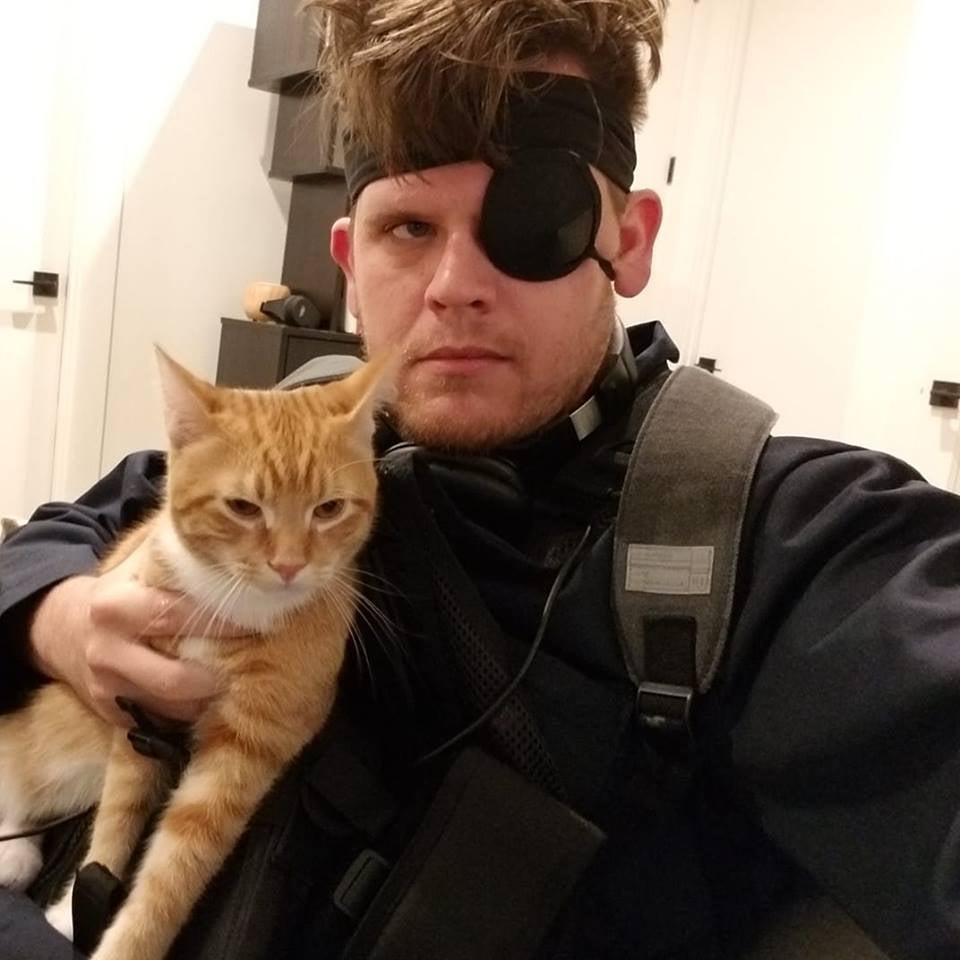In 2017, the Austin Facial Hair Club hosted the ongoing Beard and Moustache World Championship. Per usual, men trotted in exploring the eldritch extremes of what is possible in the space below your nose. Some brutalized their mane into tight curls in order to look like a low-rent Jack Sparrow facsimile; others shaved them in deeply irresponsible ways, leaving up unruly mutton chops and a bare chin. But my favorite entries, by far, were those who competed for the “Natural Goatee” title. It’s a designation that asks for no gimmicks or grooming curveballs — none of the fun, profane stuff that would motivate a man to enter a facial hair tournament. Instead, it seeks out the competitor who is, quite simply, most committed to the bit.


And so, in the images uploaded to the Facial Hair Club’s website, you can find a man named Patrick Dawson dressed in a blue blazer as a fluffy, off-white bush droops deep below his immaculately waxed long-on-top haircut. (He took second place.) Michael Burnett chugs a Lone Star and tips his cap over a jagged Shenandoah. (He came in third.) And Aaron Johnston — with his mile-wide whiskers and opaque, burgundy beard — waves to the camera like Princess Diana. He has miniature studs in each ear and thick, rectangular glasses carefully balanced on his nose; nothing about him is remotely rugged, save for the mountain of hair flowing down his chest. Johnston was the winner, however, beating out a field of 30.
The aesthetic at play here is familiar to anyone who has experienced the sour pangs of aimless masculinity: Some young men, in search of a unifying selfhood after cycling through countless other purposes, eventually settle on being a Beard Guy. Long before quarantine, where American citizens rediscovered their facial hair out of survivalist necessity, these men elected a Paul Bunyan aesthetic by choice. They flourished in the late 2000s and early 2010s, right alongside the rest of the hipster renaissance, and their defining stylistic aspiration was a more intimate connection with masculinity and Americana — at least compared to the other fashion movements of the time. Throw out the skinny jeans and argyle sweater vests, embrace the checkerboard flannel, semi-ironic bolo ties and elaborate pomades embossed with saloon-style fonts. Most of them could be found in dense urban centers, and almost none could camp to save their lives.
But for a brief moment, American men unanimously concluded that they could only identify with a comically hyper-macho, but still reflexively liberal, interpretation of themselves.
The culture heaved. In came Edward Sharpe, Marcus Mumford and Devendra Banhart. There was a countrywide reappraisal of shrimp and grits; a boom time for cured meats. Men everywhere were gripped with a renewed fascination for the mythic, character-building attributes of blue-collar handiwork. Nick Offerman, who played Ron Swanson on Parks and Recreation and truly became the It Man of this perplexing period of machismo, took multiple books to the top of the New York Times bestsellers list. The latest, Good Clean Fun, features a collection of woodworking instructionals. Gumption, from 2015, offers an extended meditation on Teddy Roosevelt’s passion for the outdoors. All of these signifiers — this off-kilter tandem of proud, cisgender virility and Obama-voting bourgeois wokeness — was centralized on the pièce de résistance: a big bushy beard. You could call it a reclamation of sorts — sprinkling a little bit of metropolitan wokeness on good, old-fashioned rural chicness.
“Hipsterdom,” as a movement, was tamed over the last 10 years. When Phoebe Bridgers is a pop star, clearly the firewall has been sundered. No longer can you spot the subtle gradations of hipster subtypes on the streets. The bookish wimps in skinny ties are extinct, same with the Pabst Blue-crushing dirtbags or the alt-bros in vintage Gary Payton jerseys. Beard Guys are mostly gone, too, expelled from the culture by the undefeated forces of cringe.
But 18 years after the first Iron & Wine album, I’m still fascinated by their legacy. Everything about the Beard Guy ran against the hipster grain. Why was it that in the midst of the decadent 2000s, some men decided that happiness could only be found in a converted farmhouse? What sparked these fraught, trad-husband shivers? This strange period of straight male identity politics? How could someone be so personally invested in the integrity of their beard, that they’d enter a tournament to empirically prove its superiority?
Christopher Oldstone-Moore, a scholar at Wright State University, has some of the answers. He literally wrote the book on the subconscious decisions dudes make when they grow facial hair, and he explains that there’s an immortal sense of rebellion associated with beards. That reputation was instituted in the Western hemisphere by the European revolutionaries in the 19th century, the rakish, debonair movie stars of the 1930s and the newly radicalized hippies in the 1960s. “[Today’s bearded hipsters] fall into a long and well-established tradition of seeing beards as symbols of nonconformity and autonomy,” he tells me. In fact, Oldstone-Moore goes as far as to say that any man — adrift and inclined to rediscover their relationship with authenticity and the natural world — will end up with some scruff to demonstrate that worldview. It’s practically innate.
“The hipster beard isn’t so much a choice for them, but a virtual requirement. They have to choose a beard to be on the side of independence, because that’s what it’s meant for a long time,” he says. “It’s almost like you can’t not do it, because the shaved face is simply the wrong look for those moving away from the normative bourgeois code, which, though more tolerant of facial hair than in years past, still prioritizes the clean-shaved look.”
Of course, this opens the question to what, exactly, the Offerman-bred hipsters of the 2010s were rebelling against. It’s true that Friedrich Engels sported a forest of snowy facial hair, but he was simultaneously destabilizing the bondage of classes. Yes, there are a lot of wooly faces in the crowds at Woodstock, but antiwar agitation was fundamental to the hippie identity. The Modern Beard Man carried none of those consolidated axioms; in fact, I’d argue that the hipsterdom of the 2010s was one of the most politically inert cultural factions in history. Sure, there might be some vague tendrils connected to Occupy Wall Street and the precarity handed down by the housing crisis — certainly, that sort of economic destabilization would make anyone consider ditching the population centers for a hermetic lifestyle in the Carolina wilds — but the bearded men we speak of aren’t activists. By and large, they’re here for the vibes and a quiet life.
Oldstone-Moore believes that the core dissent represented by the modern Beard Men is a desire to be perceived as something other than “conventional middle-class professionals.” Or more directly, to demonstrate to the rest of the country that their lives are more profound than the average American yuppie. So, not necessarily a political ideology, but certainly a social one.
I’ve seen what Oldstone-Moore is describing firsthand. I lived in Austin in the early 2010s, and I watched beleaguered urbanites pour into that city, and every other non-coastal Democratic bastion, by the thousands during that time. They were in search of a haven closer to the earth; the millennial version of the John Wayne fantasy. The dream was to leave an unfulfilling junior advertising career behind and get a job sourcing hops for a craft brewery or some such thing. The newfound provincial freedom for these settlers encourages a corporeal rebirth, and soon enough, a scraggly new veneer sprouts from their pores. The beard thrives out of a curdled defiance for parents, former bosses and the therapists who recommended graduate school — anyone who discouraged the idea that absolution couldn’t be found in the hazy, debauched inertia of bucolic living with a liberal arts degree. Together, these men created a class of furry bachelors donned in overalls, septum piercings and sailor tattoos, with none of the hardscrabble bona fides of the true agrarians a few miles outside of downtown.
To me, that’s the true contrarian spirit of all the ancestral Beard Guys. They weren’t chasing a political objective or a justice mission, but they were cracking under the manifold pressures of what it meant to be a man. As the job market narrowed and real-estate prices spiked, it was only natural for some confused twentysomethings to adopt a brand new pastoral personality with the help of a few semantic poses. No longer condemned to a life of hustle, these boys were now hundreds of miles from Brooklyn, playing bass in a folk band and whittling wooden spoons in the muscular Offerman tradition. It’s hard to blame them — that lifestyle is no less counterfeit and dehumanizing than coding all day for a vicious startup. Obviously, growing a gigantic beard to feel something is hilariously deranged, but if I’m honest with myself, I do see where they were coming from.
Annie Fichtner, a lifelong Austin resident, tells me that she was one of the casualties of the Beard Men era, in the sense that she was seduced by them constantly. In high school, she was infatuated with the sort of dudes that headlined Warped Tour — eyeliner, spiky haircuts and maybe 120 pounds soaking wet. But by the time she arrived in college, she found herself surrounded by a generation of bachelors reaching deep within themselves to dredge up a dormant uber-masculinity — a masculinity that was suddenly in vogue, as the Magnetic Zeros’ “Home” went platinum.
Gradually, Fichtner noticed a change within herself. Suddenly she found herself embracing a “super feminine” silhouette — red lipstick, cowboy boots and white dresses — aligning with the fraudulent cowboy pastiche of the men she wanted to date. “I wanted to appeal to those dudes. I thought if any ounce of me seemed masculine, they were so masculine that it would be too much for the relationship,” she says. “I matched them in order to be seen as attractive. There were a lot of beard competitions. I went to lumberjack festivals. It was just everywhere. Pop culture dictated what I liked.”
Fichtner, of course, would eventually see through the facade. After enough dates with a variety of different Beard Men, she concluded that the vast majority of them were hopeless charlatans with a troubling absence of tact and no interiority to speak of. No matter how committed a man might be to his newfound rustic character, artifice can only take them so far. After a while, Fichtner considered how phony her own obsessive commitment to femininity was, and today she enjoys indulging in her masculine qualities when she feels like it. Since graduating college, Fichtner has sworn off dating anyone with a beard, though that changed briefly in 2020. “My current boyfriend grew a beard during quarantine, but he also paints his nails and watches trash TV with me,” she says. “He’s very cool with embracing both sides of his sexuality, and that’s what is attractive to me at this point.”
I hope that is the conclusion that every former Beard Guy eventually reached. You can buy up all the beard oil in the country; you can carve a thousand finely hewn ladles; you can worship day and night at the Church of Offerman and indulge in your favored rules of liberal machismo; but no beard is big enough to cover up the yawning void in the depths of your soul. I like to imagine them giving up the ghost, shaving down to a light layer of salt-and-pepper stubble and tossing their Lumineers records out the window. Finally, they can be as masculine as they want, in whatever shape that may be.

